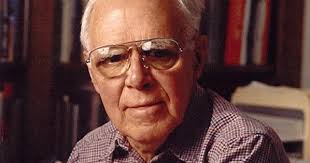So now that it has been just over a week since last week's, Puzzle of Persistence, I think it's time to finally reveal how to solve this puzzle and how it was made.
I first need to give a shout out to RedHood1013. He caught me on FB and presented his solution this morning. 100% Correct. Congratulations!
In order to show you how to solve this puzzle, I need to first give you the elements that created the puzzle in the first place.
 The clue that was hidden within the puzzle that hinted at both the puzzle's mathematical nature, as well as the fact that I was looking for multiplicative persistence was the name - Martin G., or Martin Gardner. (That Guy right there >>>>>>>>>>>>>>>>>).
The clue that was hidden within the puzzle that hinted at both the puzzle's mathematical nature, as well as the fact that I was looking for multiplicative persistence was the name - Martin G., or Martin Gardner. (That Guy right there >>>>>>>>>>>>>>>>>).
Now, going back to our puzzle. Our names have the following levels of persistence.
I first need to give a shout out to RedHood1013. He caught me on FB and presented his solution this morning. 100% Correct. Congratulations!
In order to show you how to solve this puzzle, I need to first give you the elements that created the puzzle in the first place.
Making Puzzle of Persistence
The first element involved in this puzzle is actually a very simplistic cryptography method. It is a method of using names to stand in for numerical values. In this case, each name is actually a number. To derive the numbers, we are using a summed value of each letter's position in the English alphabet. Names are as follows:
Valyrie L. - 104
James C. - 51
Kevin A. - 62
Zander I. - 77
Martin G. - 82
Nadia J. - 39
Taking the values of the names, you now can determine which is smallest and which is largest. Simple.
What about persistence?
Well, the reason the puzzle is worded oddly is because I am speaking of mathematical persistence. There are two types of persistence, additive and multiplicative. Now if you have had at least 5th-grade math, then you have learned about persistence (though you may not realize it). Most people are familiar with additive persistence and learn about it normally while doing the 9's times table. This is where you learn that if you sum the digits in a multiple of 9, then the numbers will eventually add up to 9. The number of times you have to add the digits to get to 9 is that numbers additive persistence. Multiplicative persistence is the same, except you multiply the digits of the number and count how many times you can do this until you get to a single-digit number.
Martin Gardner (October 21, 1914 – May 22, 2010) was a mathematician who created some difficult and unique math logic problems. In fact, one dealt with multiplicative persistence and I argue that it was one of his most famous logic problems.
His original puzzle went like this:
A number's persistence is the number of steps required to reduce it to a single digit by multiplying all its digits to obtain a second number, then multiplying all the digits of that number to obtain a third number, and so on until a one-digit number is obtained. For example, 77 has a persistence of four because it requires four steps to reduce it to one digit: 77-49-36-18-8. The smallest number of persistence one is 10, the smallest of persistence two is 25, the smallest of persistence three is 39, and the smaller of persistence four is 77. What is the smallest number of persistence five?In case you are wondering, the answer is 679.
Now, going back to our puzzle. Our names have the following levels of persistence.
Valyrie L. - 1
James C. - 1
Kevin A. - 2
Zander I. - 4
Martin G. - 2
Nadia J. - 3
For more puzzles and other tips and resources, Please, PLEASE comment, follow (Twitter, Facebook, Google+, and now Pinterest) and share this or any other blog post of mine. Everything I do is for free. The only reward and motivation I receive is getting more than 10 page views/day. (There are ads, but in 2 years I've racked up $1.30. Google doesn't pay you until you hit $100.)

Comments
Post a Comment